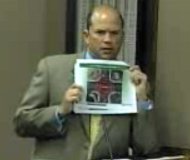3/22/2012
Arizona: Simple Definition Change Will Reduce Red Light Camera TicketingArizona Senate committee changes definition of intersection to reduce the number of red light camera tickets.

Arizona lawmakers who failed to pass a ban on automated ticketing machines are doing the next best thing. They are re-writing the laws to make it harder for red light camera companies to issue "gotcha" tickets to motorists. The state Senate Appropriations Committee voted 8-4 to adjust the definition of an intersection to, in effect, give motorists more time to clear an intersection before seeing a flash in their rear-view mirror. State Senator Frank Antenori (R-Vail) introduced the amendment to bring the state code into compliance with federal regulations, as established in the Manual on Uniform Traffic Control Devices (MUTCD).
"Currently, with the exception of Alaska and Arizona, this is the law in every state in America," Antenori explained on Tuesday. "We're the only states that do that, and it creates confusion."
The Federal Highway Administration has noticed Arizona's failure to abide by the MUTCD, as required by federal statute.
"Some states are using the extension of the curb line to mark the boundary for red-light running regardless of whether there are stop lines or crosswalk," the agency noted in a presentation on red light cameras. "This practice is not consistent with the meaning of the red signal in the MUTCD."
In 2009, FHWA specifically chastised the city of Tuscon for painting confusing and illegal intersection marking lines in an effort to generate red light camera violations.
Antenori's language is modeled on that used by the rest of the 48 states, setting the beginning of an intersection at a stop bar or crosswalk line. A driver may legally cross these lines so long as the light is yellow and can continue through to the other side of the intersection even if the light turns red. Arizona's current law sets the red light camera trigger back between 24 and 38 feet (to the elongation of the curb line), so that drivers have less time to legally clear the intersection. The existing definition has the same effect as shortening the yellow light duration by 0.2 to 0.6 seconds, depending on the speed of traffic and size of the intersection.
Each tenth of a second are vital. About 80 percent of red light camera tickets issued nationwide are mailed to the owners of vehicles that entered an intersection less than one second after the light turned red. For most cities, the majority of citations are issued as little as 0.1 seconds after the light turns red.
A copy of the bill is available in a 30k PDF file at the source link below.


